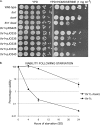Homoserine toxicity in Saccharomyces cerevisiae and Candida albicans homoserine kinase (thr1Delta) mutants
- PMID: 20305002
- PMCID: PMC2863960
- DOI: 10.1128/EC.00044-10
Homoserine toxicity in Saccharomyces cerevisiae and Candida albicans homoserine kinase (thr1Delta) mutants
Abstract
In addition to threonine auxotrophy, mutation of the Saccharomyces cerevisiae threonine biosynthetic genes THR1 (encoding homoserine kinase) and THR4 (encoding threonine synthase) results in a plethora of other phenotypes. We investigated the basis for these other phenotypes and found that they are dependent on the toxic biosynthetic intermediate homoserine. Moreover, homoserine is also toxic for Candida albicans thr1Delta mutants. Since increasing levels of threonine, but not other amino acids, overcome the homoserine toxicity of thr1Delta mutants, homoserine may act as a toxic threonine analog. Homoserine-mediated lethality of thr1Delta mutants is blocked by cycloheximide, consistent with a role for protein synthesis in this lethality. We identified various proteasome and ubiquitin pathway components that either when mutated or present in high copy numbers suppressed the thr1Delta mutant homoserine toxicity. Since the doa4Delta and proteasome mutants identified have reduced ubiquitin- and/or proteasome-mediated proteolysis, the degradation of a particular protein or subset of proteins likely contributes to homoserine toxicity.
Figures







Similar articles
-
Fungal homoserine kinase (thr1Delta) mutants are attenuated in virulence and die rapidly upon threonine starvation and serum incubation.Eukaryot Cell. 2010 May;9(5):729-37. doi: 10.1128/EC.00045-10. Epub 2010 Mar 19. Eukaryot Cell. 2010. PMID: 20305003 Free PMC article.
-
Cytocidal amino acid starvation of Saccharomyces cerevisiae and Candida albicans acetolactate synthase (ilv2{Delta}) mutants is influenced by the carbon source and rapamycin.Microbiology (Reading). 2010 Mar;156(Pt 3):929-939. doi: 10.1099/mic.0.034348-0. Epub 2009 Dec 17. Microbiology (Reading). 2010. PMID: 20019084 Free PMC article.
-
THR1 mediates GCN4 and CDC4 to link morphogenesis with nutrient sensing and the stress response in Candida albicans.Int J Mol Med. 2018 Dec;42(6):3193-3208. doi: 10.3892/ijmm.2018.3930. Epub 2018 Oct 12. Int J Mol Med. 2018. PMID: 30320368 Free PMC article.
-
Yeast cycloheximide-resistant crl mutants are proteasome mutants defective in protein degradation.Mol Biol Cell. 1997 Dec;8(12):2487-99. doi: 10.1091/mbc.8.12.2487. Mol Biol Cell. 1997. PMID: 9398670 Free PMC article.
-
Generating anchors only to lose them: The unusual story of glycosylphosphatidylinositol anchor biosynthesis and remodeling in yeast and fungi.IUBMB Life. 2018 May;70(5):355-383. doi: 10.1002/iub.1734. IUBMB Life. 2018. PMID: 29679465 Review.
Cited by
-
Optimality principles reveal a complex interplay of intermediate toxicity and kinetic efficiency in the regulation of prokaryotic metabolism.PLoS Comput Biol. 2017 Feb 17;13(2):e1005371. doi: 10.1371/journal.pcbi.1005371. eCollection 2017 Feb. PLoS Comput Biol. 2017. PMID: 28212377 Free PMC article.
-
Identification of Genes in Saccharomyces cerevisiae that Are Haploinsufficient for Overcoming Amino Acid Starvation.G3 (Bethesda). 2017 Apr 3;7(4):1061-1084. doi: 10.1534/g3.116.037416. G3 (Bethesda). 2017. PMID: 28209762 Free PMC article.
-
Metabolic Engineering of Escherichia coli for the Production of l-Homoserine.Chem Bio Eng. 2024 Jan 25;1(3):223-230. doi: 10.1021/cbe.3c00077. eCollection 2024 Apr 25. Chem Bio Eng. 2024. PMID: 39974203 Free PMC article. Review.
-
The role of the de novo pyrimidine biosynthetic pathway in Cryptococcus neoformans high temperature growth and virulence.Fungal Genet Biol. 2014 Sep;70:12-23. doi: 10.1016/j.fgb.2014.06.003. Epub 2014 Jul 7. Fungal Genet Biol. 2014. PMID: 25011011 Free PMC article.
-
Fungal homoserine kinase (thr1Delta) mutants are attenuated in virulence and die rapidly upon threonine starvation and serum incubation.Eukaryot Cell. 2010 May;9(5):729-37. doi: 10.1128/EC.00045-10. Epub 2010 Mar 19. Eukaryot Cell. 2010. PMID: 20305003 Free PMC article.
References
-
- Albrecht G., Mosch H. U., Hoffmann B., Reusser U., Braus G. H. 1998. Monitoring the Gcn4 protein-mediated response in the yeast Saccharomyces cerevisiae. J. Biol. Chem. 273:12696–12702 - PubMed
Publication types
MeSH terms
Substances
Grants and funding
LinkOut - more resources
Full Text Sources
Molecular Biology Databases

